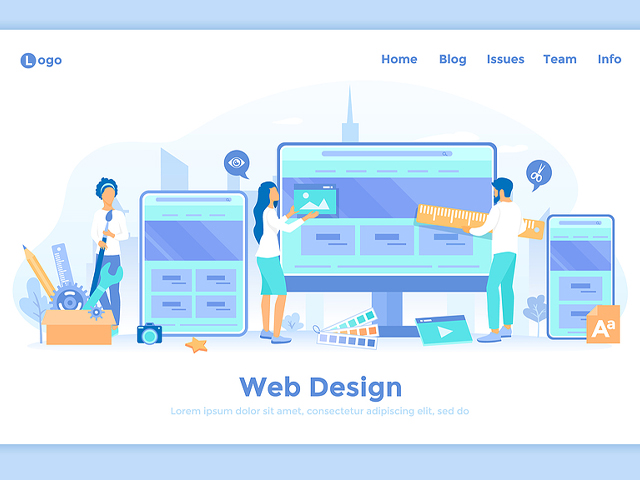
Graphic Design is an ever-evolving creative career. If you enjoy telling stories visually, playing with colors, patterns, images, shapes and more, this could be just the career you are seeking.
What are the Principles of Graphic Design?
You need to grasp the basic principles of graphic design if you want to pursue a career in this field. Excellent design is carefully mastered with lots of planning. It requires being an expert in principles and applying design theory. Graphic Designers must utilize elements including color, texture, lines, scale, emphasis and dominance, space, harmony, typography and shape. Each of these elements dramatically impacts overall design and can tremendously impact how an audience perceives the message.
Discover the Tools of Graphic Design
There are tons of different tools that Graphic Designers rely on. Typically, they utilize graphic design software. One of the most popular is the Adobe Creative Suite. You will need to get familiar with InDesign, Illustrator, Photoshop and will rely on these fun programs to create most of your design work. There are numerous training resources and user guides out there. If you need some ideas to start out, check the tutorial series offered by Adobe.
Take a Class in Graphic Design
Graphic design classes introduce you to design fundamentals and help you hone your skills by working on different projects. These classes will introduce you to peers and mentors who will help you establish your network and be invaluable to your learning curve.
Most graphic design classes will discuss the following topics: layout, software, graphic design tools, typography, color theory and more. Certain courses will cover UX or user experience, website design principles and graphic design history, depending on the depth of the class.
There are many courses available ranging from online flexible courses to structured academic classes. Find a graphic design class that works with your schedule and have fun learning new skills.
Design Personal Projects to Enhance your Graphic Design Abilities
Once you have obtained your graphic design skills, mastered the tools and understand the principles of design, you will need to practice. Create your own fun design projects to understand the intricacies of graphic design software. Pick your favorite businesses or make up companies of your own and get started developing logos and mock advertisements. Perhaps, you would like to re-do an existing company's design. This is excellent practice for designing and identifying methods. Some people offer their newfound skills on a volunteer level with non-profit groups in their vicinity. You will secure experience in the real-world and obtain more practice by offering your design skills to a variety of brands.
Create your Graphic Design Portfolio & Show your Skills
Every Graphic Designer needs a vivid portfolio. This can include work and personal projects and projects you completed for a class. Remember, your portfolio is the first impression that clients and potential employers will look at. Choose specific work that demonstrates your interests and design skills.
What are Different Kinds of Graphic Designers?
Graphic Designers may create in-house designs for one brand or business, or they may work on a huge selection of clients and brands by working at an agency. They may choose to be a freelancer and operate their own design company from home or office space. There are plenty of flexible options in this job category.
Freelance Graphic Designers
Freelancing offers unsurpassed flexibility. These Graphic Designers are self-employed and responsible for running all aspects of their business. They issue invoices, manage clients and complete their design obligations. By working with a variety of clients on a wide range of projects, it is easy to grow an extended portfolio. Successful Freelancing Graphic Designers have strong self-motivation and savvy business nature.
One of the best parts about freelancing is that these Graphic Designers can work and live anywhere and establish an individual schedule. They can be picky about which jobs they select and the types of projects they choose. However, when first starting out it is vital to develop a strong client base.
Freelance Graphic Designers must make time to market their skills and complete administrative tasks along with their design responsibilities. Freelancers need to seek out fresh opportunities and new clientele to remain as busy as they desire. There will be instances when they will compete with other Designers to secure projects.
Graphic Designers at an Agency
There are a range of clients and brands which Agency Graphic Designers work with. Since agencies are hired by external clients, the clients' needs range widely. Generally, Agency Graphic Designers work on various individual campaigns and short-term projects. This is considered to be a faster-paced environment. Agency Designers often work on numerous brands simultaneously.
Normally, there are many Graphic Designers that work at a company. Each will have a different area of expertise or specialization. Agency Graphic Designers are skilled and familiar with design principles. They work with teammates who share the same skills so the collaborative expectations are high for amazing design concepts.
This is a wonderful setting to work with gifted designers and gain insight from their unique design processes. This can be very useful for upcoming Designers who are new to the field and wish to learn from established creatives.
Graphic Designers In-House
Graphic Designers who work in-house are employed by a company or brand that is established. Generally, they require a variety of design skills to meet the business's needs. Their tasks will range from compiling annual reports, designing fresh marketing campaigns and everything in between. They may work alongside other In-House Designers in a team, or they may be the solo designer at a company, depending on how large their creative department is.
There is typically a more traditional working environment with in-house graphic design. This includes regular working hours and steady paychecks. In-House Graphic Designers require an in-depth knowledge of the brand and company they work for including the company's audience and style.
What is the Best Way to Become a Freelance Graphic Designer?
You will need to establish your network, market your skills and find clients to become a successful Freelance Graphic Designer. Excellent design skills are just one part of the equation. You will also need to know the ins and outs of running a small business. The following list breaks down some of the key components to help you find success.
Learn the Fundamentals of Graphic Design and Practice: Starting out will require that you obtain experience and knowledge in all aspects of graphic design. You can take a multitude of online courses and practice applying your abilities on your own projects.
Sell Yourself & Your Skills: Marketing and branding your business is essential to your success. Many people simply use their first or last name, or both; however, it's your brand so create whatever you desire. Once you have your brand, you can focus on creating a website and showcasing your portfolio to highlight your best projects. Ensure that your contact information is easy to read and widely available so that potential customers can find you.
Grow Your Clientele: You will want to be hired asap. Securing your initial clients will help launch your business and allow you to grow momentum and confidence. If you are seeking clients, reach out to your network and look on freelancing job websites. Speak with relatives, peers and friends to see if they know anyone who is looking for a Graphic Designer.
Exceed Expectations: On your first few projects, overdeliver to win your client's approval. Ensure you have exceptional details and maximize your skills. This will make them want to hire you again in the future or refer additional contacts your way.
Understand the Design Business: You will be running every portion of your business as a Freelance Graphic Designer. This includes writing invoices, creating proposals, marketing your skills and updating your website. The more business skills such as accounting that you can master, the more streamlined and organized your business will be.
Take On Incoming Jobs: When you are initially growing your business, you will want to say "Yes!" to the majority of opportunities that arrive. This is critical for building your base clients. After you are more established, you will have the luxury of being more selective in the jobs that you decide to take.
Create Your Network: When you are freelancing, you will rely heavily on your network. This includes family, friends, peers, potential clients, current clients and previous clients. Always keep on the lookout for new business and new clientele.
Freelancing has the reputation for being unpredictable. This can translate to working like crazy one month with tons of projects and deadlines and having little on the go the next month.
To enhance your options to have a steady workflow, it is good practice to reach out to clients every week by dedicating some connection time. This can include using social media, SEO advertisements and other marketing endeavors or good old-fashioned cold calls and networking.
Don't Be Shy To Ask For Referrals: One of the best ways to grow your client list is via word-of-mouth. Once you have impressed a client and finished a job ask them if they know anyone who may need your graphic design expertise. In time, referrals will likely happen naturally; however, asking is a great way to help build your work opportunities when you are just beginning.
What is the Best Way to Start a Graphic Design Career?
There are certain steps to take if you would like to launch a career in this field. First, learn the fundamentals of graphic design and enroll in some courses. Next practice your skills, use various design tools and work on projects. Lastly, create a kick-butt portfolio to showcase your talents.
Learning about elements and graphic design theory is the first step. You can conduct plenty of your own research online or enroll in specific courses online or attend class. Graphic design courses allow you to learn the vital knowledge you need to get to work on many different tasks. Next, you will need to get familiar with many common graphic design tools including InDesign, Illustrator and Photoshop. These tools are utilized by numerous Graphic Designers in their daily tasks. Understanding how to work with this technology and master it is essential to your success.
Your portfolio is a key piece of your puzzle, regardless of if you want to work as a freelancer, or at an agency in-house. Use your favorite personal projects or volunteer to obtain some practical experience. Potential clients and employers will be looking for examples of your work. You can include school projects as well. Broadcast your skills and showcase your abilities in your portfolio with projects you are proud to share.
It is important to grow your network. Connect with various designers and communicate with your mentors or reach out to designers that you admire. Join AIGA and other design organizations. Keep in touch with your network and continually expand to stay on the lookout for opportunities in graphic design.
Is it possible to Become a Graphic Designer with Zero Experience?
Yes! With time, even if you have zero experience, you will be able to become a successful Graphic Designer by applying and practicing your abilities and expanding your network. There are a few things you can do to get started below:
Connect with Design Agencies
Introduce yourself to agencies that you admire and your favorite design teams. Ask if they would consider offering an informational interview to learn more about their work. Send in samples of your projects and keep in touch with various design agencies. They may have an opening in the future. This is a great way to keep them interested in your work.
Volunteer or Intern
Volunteer opportunities and internships are excellent ways to make connections and gain experience in the real world. Taking an internship with an agency can offer you insight into how these businesses work and prepare you for meeting with a variety of clients.
You can gain experience by offering your design skills to help charities and non-profits. Approach your local community centers, animal shelters and galleries to get started. This is a great way to combine giving back to the community and building strong connections as you move forward in your design career.
Create your Specialty
Specializing in one of the design aspects can help you stand out from the crowd. This can be helpful when you apply for jobs. You will have a general design knowledge ranging across all areas however, you might focus on animation, web design, designing logos or typography.
Understanding your User Experience or UX
UX or user experience design relies on product function and usability. Learning the fundamentals of UX can help you stand out as a job candidate and enhance your work efforts. Graphic Designers commonly work beside Web Developers and Web Designers. They will enjoy working alongside a designer who can build visuals while taking UX into consideration.
How much do Graphic Designers make?
On average, Graphic Designers make approximately 44K a year in Canada and 46K in the USA. Senior Graphic Designers in the U.S. can make up to 62K every year.
Of course, salaries will range depending on which areas you specialize in. A Web Designer ranges from 45K to 53K while a Motion Designer is approximately 62K annually. UX and UI Designers however can make between 77K and 85K.











